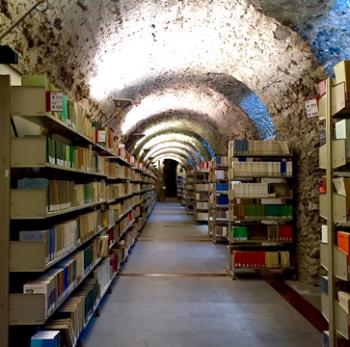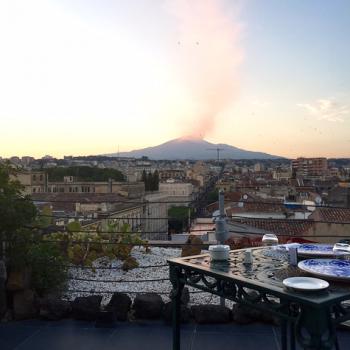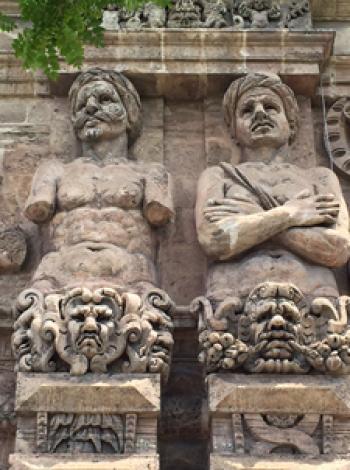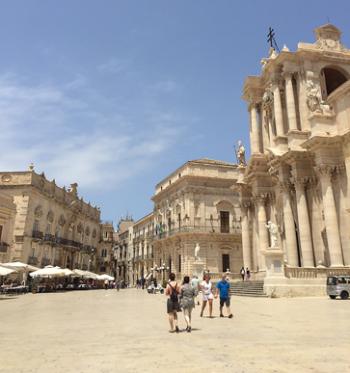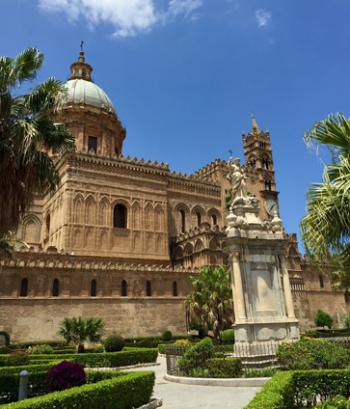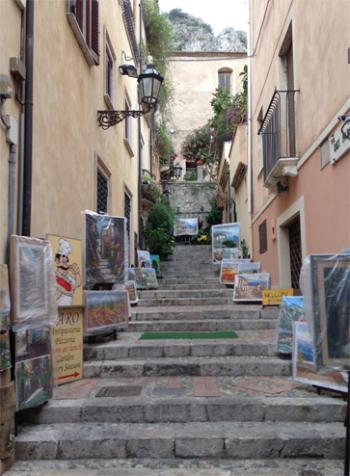Special sights in Sicily
This item appears on page 12 of the October 2016 issue.
Many friends have talked excitedly about the beauties of Sicily: ancient ruins, beautiful gardens, great scenery and delightful hotels. My wife, Ging, and I visited this island off Italy’s southeastern coast from mid-July until the first week of August 2016.
We began in PALERMO, where the one-mile port walk passes docks for ships large and small, including spectacular yachts, and leads to the beautiful Orto Botanico, the botanic and zoological gardens.
We stayed at the Grand Hotel Piazza Borsa (Via dei Cartari, 18, 90133 Palermo, Italy; phone +39 091 320075, www.piazzaborsa.it/index.php/en), located on a quiet cul-de-sac just blocks from the city center.
The hotel combines an authentically restored 16th-century church, an adjacent convent and cloisters and has a dramatic 2-story staircase. We booked through Expedia.com at €115 (near $130) per night for four nights.
The Piazza Borsa was just two blocks from a stop for a hop-on, hop-off bus that provided convenient access to some of our favorite sites, including the Quattro Canti district, with the Royal Palace and the Palatine Chapel, and the magnificent Teatro Massimo, the biggest opera house in Italy and third-largest in Europe.
It also stopped at the vast La Vucciria market, which opens at 4 a.m. daily (except Sunday) with freshly caught fish and just about every variety of fresh and packaged Italian food. (Olive oil and spices make great souvenirs.)
We took a slow but scenic train ride around the coast to CATANIA on Sicily’s east side. We chose this city because it’s less than an hour from both Siracusa and Taormina, which we visited on day trips.
We stayed five nights at the centrally located UNA Hotel Palace (Via Etnea, 218), a century-old property in the artistic and commercial district, just a 10-minute walk from Piazza Duomo (Cathedral Square). We had booked directly through their website (www.una hotels.it) at €125 nightly.
Restored in classic Sicilian style, the Palace had a dramatic 3-story lobby with a grand staircase, but, for us, the hotel’s outstanding feature was the Etnea Roof Bar & Restaurant, with its excellent view of Mt. Etna, the highest active volcano in Europe. For just €12 each, you can have cocktails and canapés at sundown and view lava and ash spewing just 15 miles away. (Locals told us that the best views of the volcano are from Taormina, 20 miles north, or Catania, 15 miles south.)
After dark, we watched a wonderful ballet performance as bats soared and dived for their evening meal.
In addition to the magnificent Duomo, Catania had attractions that did not disappoint.
The city’s botanical gardens, Orto Botanico dell’Università di Catania, were outstanding and provided a peaceful atmosphere. The two main sections have a hundred varieties of palms, giant cereus and opuntia cacti, while another section highlights local plants.
In Sicily, examples of Greco-Roman and, occasionally, Arabic ruins were often only a few blocks from our hotels. In Catania, these were not on a grand scale, but each was interesting in its own way.
Catania is also home to the Benedictine Monastery of San Nicolò (Piazza Dante, 32), a UNESCO World Heritage Site. Completed in the 18th century after being destroyed in the great earthquake of 1693, the monastery features two 3-story cloisters.
Remnants of the original kitchens, monks’ cells, chapel and abbot’s apartment could be viewed, but most unique were the university library and study halls in the lowest level, which survived the great earthquake. They were built into and around the original catacomb facilities. Admission was by tour only; we took one of the English tours (€4 each).
We took the one-hour train ride to TAORMINA on a Wednesday but found it so crowded that we cut our planned full day there to about five hours. Even with a broad, pedestrian-only main walkway, the crowds in the historic city center made New Year’s Eve in Times Square seem like midnight in Beloit, Wisconsin.
We did find its Greek Theatre an excellent stop. It’s restored and is still used for concerts and plays. There are also many beautifully landscaped small streets and alleys in Taormina, but we found the central area to be over-commercialized.
On our final day, we took the one-hour train ride from Catania to SIRACUSA, a World Heritage Site and considered by many the most beautiful Sicilian city. Its fifth-century Greek theater, later rebuilt by the Romans, is among the best-preserved ancient theaters.
L’Isola di Ortigia, an island in the Mediterranean adjacent to Sicily, is home to the Doric Temple of Apollo and the lovely Montalto and Archimedes plazas, which date back to the 14th century.
An hour’s walk around the island is a must for viewing the beautiful shoreline and the Castello Maniace. You can see many Baroque and medieval sites and structures along the way.
In Piazza Minerva, don’t miss the Ionic Temple of Artemision, now a small archeological museum with fascinating burial sites easily viewed from ground level or a suspended walkway.
Back in Catania and our hotel, we returned to the Etnea Roof Bar to enjoy some excellent and inexpensive Sicilian wine while we watched the show.
FRED STEINBERG
Riverside, CT

